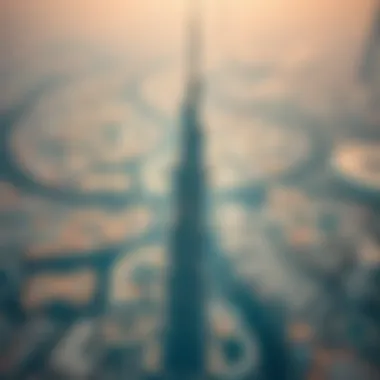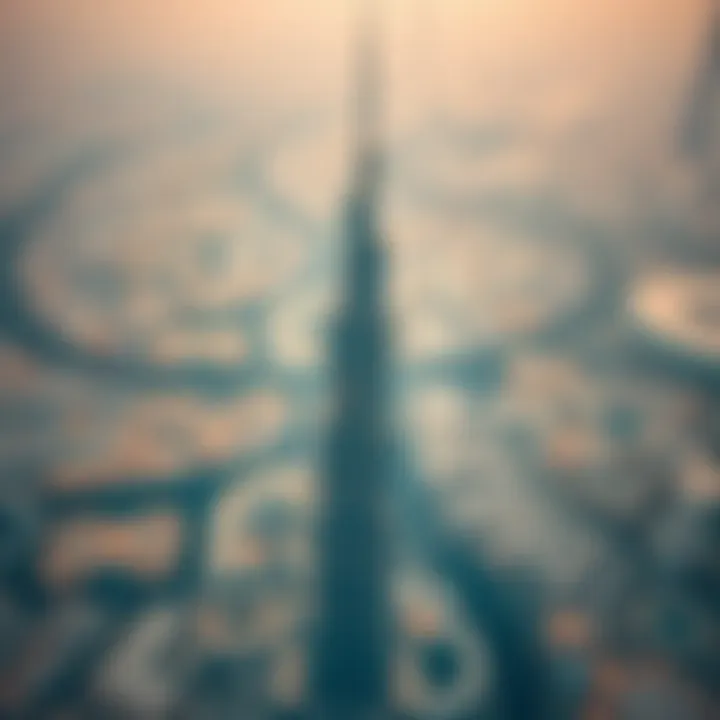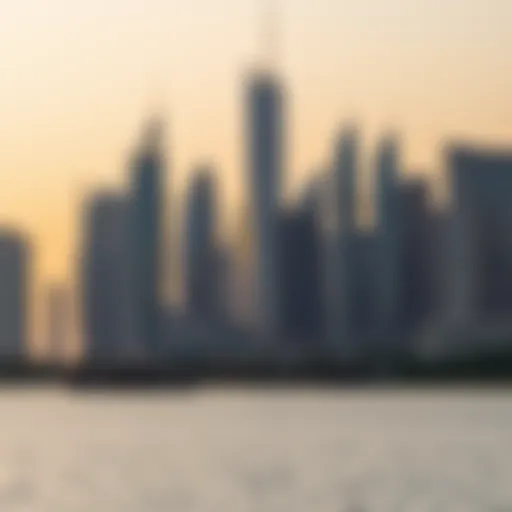The Construction Timeline of Burj Khalifa: An In-Depth Analysis


Intro
The Burj Khalifa, towering at a staggering height of 828 meters, is not just a building; it is a symbol of ambition and innovation in architecture. The construction of this iconic structure began in 2004 and finished in 2010, yet its story doesn’t just lie in the completion date. From groundbreaking to its grand opening, the journey was fraught with challenges, cutting-edge technology, and significant milestones that transformed the Dubai skyline. Understanding the timeline of this architectural marvel unravels the complexities and triumphs that have shaped not only its development but also the real estate landscape of Dubai.
As investors and stakeholders dive into the Dubai market, understanding the construction and significance of Burj Khalifa provides crucial insights. This skyscraper serves as a barometer for market trends, reflecting the economic conditions and architectural ambitions of its time. This analysis will delve into the timeline of construction, while also weaving in the broader context of market trends and investment opportunities, making it invaluable for those looking to navigate the dynamic realm of Dubai real estate.
Market Trends
Current Market Analysis
The Burj Khalifa isn't merely a tall building; it's a lighthouse for investment in Dubai's real estate sector. Since its completion, the surrounding market has seen a mix of luxury development and high-potential opportunities. Properties near CBDs, especially in Dubai, have seen a heightened interest, thanks to increased tourism and a steady influx of expatriates. Investors are now keen to tap into this growing trend, particularly in Downtown Dubai, where the Burj Khalifa stands as a centerpiece.
In recent years, luxury apartments and commercial spaces within this vicinity have skyrocketed in value. This surge indicates a robust demand driven by international investors and businesses looking for prestigious footholds in the emirate. A shift in demographic preferences, where younger professionals seek vibrant urban living, further propels this trend forward.
Future Predictions
Looking ahead, predictions for the Dubai real estate market remain positive. If analysts are to be believed, the significant investment in infrastructure and hospitality, characteristic of the Expo 2020 event, will drive up property values even further.
- The impact of upcoming residential and commercial developments is expected to align closely with the interests of those investing around the Burj Khalifa.
- Enhanced transportation links and international accessibility are definite game-changers set to reshape neighborhoods.
- Smart city initiatives and sustainable building practices are anticipated to attract not just investors, but also eco-conscious buyers.
"The Burj Khalifa is more than merely a building; it's an ongoing story of aspiration, progress, and a reflection of the dreams of a city."
As urban areas undergo redevelopment, especially in close proximity to major landmarks, other neighborhoods may emerge as hotbeds for investment. However, it’s crucial for investors to maintain a keen eye on market indicators and trends that provide them with a clearer path to opportunity in this landscape.
Continuing further into the timeline allows us to paint a richer picture of Burj Khalifa’s construction and the impact it has had on the cosmopolitan fabric that is Dubai.
Prelims to Burj Khalifa
The Burj Khalifa stands as an iconic symbol of modern architectural achievement, attracting attention not only for its height but also for its cultural significance. Within the narrative of its construction, one can uncover a narrative rich with diverse elements that extend beyond mere bricks and mortar. This introduction serves as a foundational stepping stone for understanding what the Burj Khalifa represents in both local and global contexts.
Historical Context
The journey towards the Burj Khalifa began when Dubai was still carving out its identity as a major player on the world stage. Prior to the construction of this towering skyscraper, the city was known mainly for its oil wealth and rapid development. However, in the late 1990s, a decision was made to further establish Dubai as a thriving cosmopolitan hub. The thought was to build something that would not only draw international attention but also catalyze tourism and investment. Thus, the vision of the Burj Khalifa was born.
The construction project was led by Emaar Properties, a developer with aspirations of creating a landmark that would encapsulate the UAE’s ambitions. Designed by Adrian Smith of Skidmore, Owings & Merrill, the building's design was influenced by Islamic architecture and local traditions, while also showcasing global modernity. This historical context is crucial for understanding the steps that followed, illustrating how the Burj Khalifa was conceived as much more than a mere structure—it's a narrative woven into the very fabric of Dubai's growth.
Purpose of Construction
At its core, the Burj Khalifa was built for a myriad of purposes that extend far beyond its towering silhouette. Primarily, it was envisaged as a mixed-use space that combines residential, office, and luxury hotel accommodations. With over 160 floors, it houses everything from lavish apartments to high-end offices and the luxurious Armani Hotel.
However, its significance reaches into the realms of economics and culture as well. The Burj Khalifa serves as a magnet for tourists from across the globe, significantly contributing to Dubai's economy. Moreover, it stands as a testament to what can be achieved in the face of ambition and innovation.
In summary, the Burj Khalifa is far more than a structural feat; it is a reflection of Dubai’s socio-economic landscape and aspirations, which played an essential role in its construction. This article will delve into the intricate details of its construction timeline, providing insights that speak to its significance and the milestones achieved along the way.
Initial Planning and Design Phase
The foundation for any monumental structure lies in the planning and design phase. This stage sets the blueprint not just for the architecture, but for the broader vision of what the building will represent. In the case of the Burj Khalifa, the significance of this phase cannot be underestimated. It involved a melding of creativity and practicality, where dreams danced with the challenges of engineering. Ultimately, this phase was vital for ensuring that the Burj Khalifa not only met aesthetic criteria but also operational necessities, considering its record-breaking height.
Architectural Inspiration
The Burj Khalifa drew its architectural inspiration from a variety of sources, which played a crucial role in its uniquely recognizable silhouette. The overarching design concept stems from traditional Islamic architecture, particularly the minarets, evoking a sense of cultural relevance. Yet it does not stop there.
Key Inspirations:
- The Hymenocallis Flower: The building's three-winged base mimics the shape of the desert flower, providing a distinctive geometric form.
- Islamic Architecture: Patterns and motif designs from Islamic culture harmonize with contemporary design, creating a bridge across history.
Moreover, the lead architect, Adrian Smith, sought to blend form with function, capturing wind dynamics and sunlight to facilitate energy efficiency. The home's aesthetic was paramount, as it needed to represent Dubai’s ambitions on the global stage. The attention to detail reflects not just personal vision but a collective aspiration, melding art and engineering into a seamless act of creation.
Site Selection Process
Selecting the right site for such an unparalleled structure as the Burj Khalifa was no small feat. The site chosen served as the centerpiece of the broader urban planning in Dubai, aligning with the city's growth trajectory. A detailed analysis involved studying various factors such as geographical conditions, accessibility, and cultural significance.
Factors Influencing Site Selection:


- Geographical Suitability: The ground condition required extensive geological studies, ensuring stability for a building of such height.
- Accessibility: Proximity to key infrastructure, like the Dubai Metro and major roadways, was essential, allowing easy access for both workers and visitors.
- Aesthetic Impact: The site needed visibility from various parts of the city to enhance its iconic status, effectively becoming a focal point in Dubai’s skyline.
The decision-making process did not merely focus on logistics; it also engaged local community stakeholders. This layered approach ensured that the Burj Khalifa would not simply be a standalone monument but a harmonic part of the urban intricate.
Construction Timeline Overview
The construction timeline of the Burj Khalifa is not just a series of dates and events; it’s a narrative of innovation, ambition, and meticulous execution. In this section, we will dissect the timeline into its vital components, illustrating the journey from the initial groundbreaking ceremony to the structure's remarkable completion. Understanding this timeline is essential, especially for stakeholders like investors, agents, and analysts, as it provides insight into the complexities that shape monumental projects.
This overview serves several important functions:
- Clarity: It provides a clear view of the entire process, revealing critical milestones that paved the way for this architectural marvel.
- Justification of Time and Resources: Each phase of construction required extensive planning and investment. The timeline showcases how each stage contributed to the structure’s final form, justifying the resources and time committed.
- Learning from Experience: By studying the successes and challenges during the construction, future projects can draw lessons, ensuring that history does not repeat itself in terms of miscalculations or oversights.
In essence, this overview is not merely a passage of time but a comprehensive guide to the managing and crafting of one of the world’s most iconic skyscrapers.
Groundbreaking Ceremony
The groundbreaking ceremony for the Burj Khalifa took place on January 6, 2004. This moment marked a pivotal turning point for Dubai, reflecting its ambition and vision for the future. With a shovelful of dirt, representatives from Emaar Properties, along with government officials, laid the foundation for what would become a symbol of modernity and engineering prowess. This event was not just a formality; it was a declaration—an announcement to the world that Dubai was ready to ascend to new heights, quite literally.
The ceremony itself was a celebration, showcasing the cultural significance of the project to the people of Dubai. Dignitaries and the media raised their shovels in unison, capturing the moment where dreams met the earth. The start of construction signified much more than laying bricks; it set into motion a series of complex operations that would see an unprecedented level of innovation and engineering excellence.
Key Milestones
Throughout the construction of the Burj Khalifa, several key milestones served as markers of progress. Each one holds its own story and significance:
- Core Completion (2006): By early 2006, the concrete core had reached a staggering height of 400 meters. This was a moment of great pride, illustrating the ability of the labor force and technology available at the time.
- Reaching the 100th Floor (2007): When the builders celebrated the completion of the 100th floor, it was a breath of fresh air; it solidified the architectural integrity of the structure and demonstrated that the project was ahead of schedule.
- Topping Out (2008): The literal crowning moment came on January 17, 2009, when the final spire was installed, marking Burj Khalifa's final height at 828 meters. This moment was not just a feat of physical construction; it was a symbol of what human determination can achieve.
Understanding these milestones provides insight not just into the construction process but also into the broader economic and cultural aspirations of Dubai.
Final Completion
The Burj Khalifa was officially inaugurated on January 4, 2010, during a grand ceremony that attracted attention from around the globe. While the structure was completed earlier in the year, the inauguration symbolized the culmination of years of hard work, planning, and perseverance.
At its completion, the Burj Khalifa stood not merely as a skyscraper but as a pinnacle of modern architecture. The project incorporated numerous state-of-the-art technologies and building techniques, such as high strength concrete and an innovative cooling system. It was a testament to what a team of architects, engineers, and laborers could achieve when they combined expertise and vision.
"Burj Khalifa is not just a building; it's a declaration of humanity's potential for greatness."
In closing, the construction timeline overview encapsulates the stages of development that are crucial for understanding the Burj Khalifa. Each phase interlocks, offering lessons and insights that are beneficial to current and future stakeholders in the construction and real estate sectors.
Materials and Methods Used
When it comes to monumental projects like the Burj Khalifa, both materials and construction methods play crucial roles. They not only affect the timeline but also the quality and sustainability of the structure. A thoughtful selection of materials, along with innovative methodologies, can lead to remarkable efficiencies in construction while ensuring the durability and resilience of the building. This section aims to illuminate the various materials and construction techniques that helped shape Dubai's iconic skyline.
Innovative Construction Materials
The selection of materials for the Burj Khalifa was no ordinary task; it required a blend of durability, aesthetic appeal, and efficiency. One standout material was high-strength concrete. This was vital because the towering height of the building necessitated materials that could withstand immense pressures and forces.
A case in point is the concrete used in the Burj, which had a compressive strength of 120 MPa. For reference, standard concrete typically ranges from 20-30 MPa. The decision to employ such a robust material not only contributed to the building’s stability but also significantly reduced the overall weight of the structure.
In addition to concrete, the building utilized glass and aluminum extensively, making it both visually striking and energy-efficient. The reflective windows were crafted to minimize heat gain, helping to maintain a comfortable indoor climate without straining cooling systems. This approach aligns well with contemporary sustainability considerations, highlighting the commitment to eco-friendly practices in the construction.
High-quality insulation materials were also used, which further reduced energy consumption. These choices stem from a strategic mindset, focusing not just on present utility but also on long-term environmental impact.
Construction Techniques
The methods employed during the construction of the Burj Khalifa were as groundbreaking as the materials. The builders faced a set of daunting challenges due to the building’s height and the unique environmental factors of Dubai, such as extreme heat and winds.
One noteworthy technique was the use of a "high-rise core approach." This technique involved constructing the tower's core first, which serves as the spine of the building. It was erected using a slipform system, which allowed for continuous pouring of concrete. This not only expedited the construction timeline but also enhanced the structural integrity of the building.
This innovative method allowed workers to pour the concrete that formed the elevator shafts and stairwells simultaneously as they moved upward, minimizing both time and material waste.
Another significant technique was the implementation of a specialized crane system designed for the unique needs of the Burj Khalifa. These cranes were able to lift heavy materials up to great heights, something that was critical in a project where traditional cranes would have struggled to reach.
In terms of logistical planning, careful scheduling and resource allocation assured efficiency. Workers were organized in a manner that ensured that tasks overlapped without disrupting one another, thereby maximizing productivity at all phases of construction.


Through strategic choices in materials and the adoption of innovative construction techniques, the Burj Khalifa stands as a testament to what can be achieved when modern engineering and design converge. This intersection not only underpinned the building's structural resilience but also contributed to its status as a landmark achievement, drawing the attention of investors, agents, and buyers alike who are keen to understand the complexities behind such monumental successes.
For further insights, you can explore more about the construction materials used in high-rise buildings at Britannica.
Challenges Faced During Construction
The construction of the Burj Khalifa was no walk in the park. It faced a multitude of challenges, each requiring innovative problem-solving and sheer determination. Understanding these challenges not only sheds light on the monumental task of building this skyscraper but also highlights the complexities involved in undertaking such a project in a place like Dubai. The hurdles encountered during construction were pivotal, impacting both timelines and costs, and they played instrumental roles in shaping the strategies employed.
Weather and Environmental Challenges
One of the most significant obstacles was undoubtedly the weather. Dubai's climate, characterized by scorching heat during the summer months, posed real threats to the construction schedule. Temperatures often soared beyond 50 degrees Celsius (122 degrees Fahrenheit). This extreme heat posed risks not just for the labourers but also for the materials being used. For instance, concrete hydration becomes critical in such heat to prevent cracking.
To address this, construction teams had to implement various techniques like shifting work hours to the cooler parts of the day. Nights became a busy time for construction activities, using floodlights to ensure safety and efficiency. Additionally, special types of concrete were developed that could withstand high temperatures and cure effectively in the scorching heat. This was just one example of adapting to environmental demands.
Moreover, Dubai's proximity to the Arabian Gulf presented another layer of complexity. The potential for sandstorms could halt progress abruptly. These storms, while not frequent, could require delays in work and protection of materials on-site. Adapting to such conditions involved both preemptive strategies as well as ensuring that equipment and personnel were ready for quick responses.
Logistical Challenges
Logistics played a crucial role in the construction success of the Burj Khalifa. The sheer scale of the project required careful orchestration of materials, equipment, and workforce. Sourcing materials from around the world, ensuring timely deliveries while navigating the hustle and bustle of Dubai, was no small feat. For example, when it came to glass panels for the façade, specific designs from Italian manufacturers had to be shipped, necessitating advanced planning for both handling and installation.
Additionally, transporting heavy construction equipment within the site raised several safety concerns. The team had to develop a meticulous plan to minimize congestion and reduce the risk of accidents. This involved designated transport routes and scheduling deliveries during off-peak hours to ensure a smooth operation.
Moreover, the construction height itself introduced logistical nightmares. Many of the materials needed to be hoisted to great heights and this required innovative solutions, such as utilizing high-capacity cranes that could maneuver within the tightly packed site dimensions.
"Navigating logistical challenges was as complex as the building itself—a delicate balance of timing, resources, and rigorous planning."
Tankers for water supply and heavy machinery were required to run non-stop, often relying on alternate power supplies to ensure the workflow remained uninterrupted. The reliance on such advanced logistics proved essential, setting new standards for future construction projects, and paving the way for a different approach to handling large-scale developments.
Through all these challenges, the team didn’t just build a skyscraper; they forged a legacy of resilience, creativity, and technical prowess. The journey of overcoming difficulties honed their skills and propelled the project toward becoming a pivotal landmark in architecture and construction.
Technological Innovations
The construction of the Burj Khalifa wasn't just about reaching heights; it revolved around pushing the boundaries of what contemporary engineering could achieve. Technological innovations played a foundational role in this architectural marvel, significantly influencing the construction process and the building's long-term functionality. At the core of the Burj Khalifa’s construction were advancements that improved efficiency and safety, while also addressing environmental concerns.
Use of Advanced Technology
One of the standout features of the Burj Khalifa's construction is the use of advanced technology that was cutting-edge at the time. The construction team employed a variety of modern methodologies that not only streamlined the process but also elevated the project’s safety standards. For example, the tower's unique design utilized a buttressed core structure — a heavy investment in sophisticated computer modeling was paramount to ensure stability and resilience against high winds.
The general contractor, Emaar Properties, also integrated a Building Information Modeling (BIM) system to facilitate real-time collaboration among engineers, architects, and construction teams. This approach allowed for immediate problem identification, reducing the potential for errors and costly delays.
Additionally, the cranes used during construction were no ordinary equipment. These were specially designed to lift heavy materials to remarkable heights while ensuring precision. They could hoist vast quantities of concrete and steel, essential for a project stretching toward the clouds.
Sustainability Considerations
While the ambition to create the tallest building in the world was evident, there was also a commitment to sustainable construction practices. The Burj Khalifa harnesses various technologies that focus on reducing its environmental footprint. One notable innovation is the incorporation of a high-efficiency internal cooling system, designed to optimize energy usage.
Moreover, the building features a water conservation strategy that involves collecting condensate from the air conditioning systems. Not only does this feature reduce water consumption, but it also adds to the green credentials of the Burj Khalifa, which is often perceived solely as a symbol of luxury.
The use of reflective glazing enhances energy efficiency, minimizing reliance on artificial lighting and reducing heat gain. These considerations not only contributed to the architecture's sustainability goals but also garnered praise from environmental advocates.
In summary, the technological innovations employed during the construction of the Burj Khalifa exemplify a perfect blend of ambition and responsibility. By leveraging advanced technology, the project not only reached impressive heights but also set a precedence for sustainable construction practices in high-rise buildings.
"The construction of Burj Khalifa reflects a significant leap in engineering, from both a technical and environmental viewpoint."
The integration of these innovative technologies ensures that the Burj Khalifa stands as a true icon of architectural brilliance, embodying both the future of engineering and a commitment to sustainability.
Cultural Significance of Burj Khalifa
The Burj Khalifa stands as a beacon of architectural prowess and cultural identity, projecting the aspirations of a city that refuses to be limited by its desert surroundings. It is not merely a tall building; rather, it embodies the rich tapestry of values, ambitions, and innovation that define modern Dubai. The structure’s enormity is a testament to human ingenuity, but its cultural significance extends far beyond measurements.
Symbol of Modern Dubai
Since its completion in 2010, the Burj Khalifa has transformed into a symbolic heart of Dubai, encapsulating the essence of progress and luxury. As it pierces the sky at over 828 meters, the skyscraper represents a striking contrast to the traditional aspects of Emirati culture. The building isn’t just eye candy; it narrates the story of a city which has swiftly evolved from a modest fishing village to a global hub of commerce.


Seen from any vantage point in the city, the Burj Khalifa instills pride among its residents and showcases the ambition of its leaders. This architectural marvel encourages a conversation about modernization, cultural identity, and urban development. The skyscraper also fosters a sense of place; it’s a meeting point where tourists, business professionals, and residents alike congregate.
"The Burj Khalifa is not only a skyscraper but a significant architectural identity for Dubai, a narrative of dreams delivered into reality."
Impact on Tourism and Economy
The economic influence of the Burj Khalifa rippled far and wide, drawing in tourists like moths to a flame. With millions flocking to witness its grandeur, the tower has catalyzed a substantial boost in Dubai’s tourism sector. Tourists are not only enamored by the observation decks that offer breathtaking panoramas, but they also immerse themselves in the surrounding attractions, further stimulating local businesses.
Consider the statistics: in its first few years post-completion, the Burj Khalifa saw a marked increase in visitors to Dubai. This surge translated to greater occupancy rates in hotels, increased foot traffic in malls, and bustling activity in restaurants nearby. Local attractions like the Dubai Fountain and Dubai Mall benefit directly from the influx of visitors drawn to the Burj Khalifa.
Investors keen on the Dubai real estate market can point to the tower’s role as a cornerstone for development, with properties in its vicinity often seeing significant growth in value.
In summary, the Burj Khalifa transcends its physical form, and in doing so, it represents a powerful narrative about Dubai's identity — one that champions progress, cultural convergence, and economic vitality.
Post-Construction Analysis
The post-construction phase of Burj Khalifa serves as a crucial component in understanding the building's long-term viability and significance. It is not just about its construction but also entails how the structure adapts to the changing needs of the community it serves. This section will elaborate on maintenance practices as well as public reactions, which both play essential roles in the legacy of the Burj Khalifa.
Maintenance and Upkeep
Maintaining such a towering giant is no small feat. Regular upkeep involves meticulous planning and execution. Given the extreme height and unique architectural style of Burj Khalifa, a dedicated team monitors and manages its structural health meticulously.
One essential aspect of maintenance involves inspecting and caring for the building's exterior. The glass façade, while stunningly beautiful, requires frequent cleaning. The structure stands tall at 828 meters and has over 11,000 glass panels. These panels are subject to dust, sandstorms, and environmental wear, necessitating specialized cleaning teams and equipment.
Moreover, with the maintenance teams dangling from ropes or using cranes, it’s a sight to behold! This task is performed every few months, and the methods employed are crucial to maintaining not only the aesthetic appeal of the tower but also its structural integrity.
In addition to the outer façade, regular assessments of the electrical, plumbing, and HVAC systems are vital. Any detected issues are remedied swiftly. Monitoring equipment measures factors like humidity and temperature, ensuring that occupants enjoy a comfortable environment.
Furthermore, the operation of elevators—a huge deal in a place that boasts the world’s fastest elevators—demands constant oversight. Ensuring peak performance means regular checks and sophisticated diagnostic technology, ensuring loyalty from those who visit and work within the building.
Lastly, the landscape of the surrounding gardens is also part of the maintenance plan. The greenery not only enhances aesthetics but contributes to air quality and comfort as well.
Public Reception and Critique
Public reception of Burj Khalifa has been overwhelmingly positive, which is noteworthy for a structure of its stature. When it was completed, it instantly became a symbol of ambition and architectural prowess. Many view it as a testament to Dubai's rapid ascent on the global stage.
Critique has generally centered on two main fronts: its environmental impact and its cultural representation.
- Environmental Concerns: Some critics argue that the construction of such a vertical city demands extensive resources and raises concerns regarding sustainability. Although Burj Khalifa employs various energy-efficient technologies, opinions in environmental forums like reddit.com are mixed. Enthusiasts praise the use of sustainable materials, while others voice frustrations about the ecological footprint.
- Cultural Representation: Speculations arise regarding the building's aesthetic style and its representation of Middle Eastern culture. Some suggest it reflects a desire for modernization at the potential expense of local heritage. However, supporters argue that it stands as an innovative blend of traditional Arabic design and modern engineering.
"Burj Khalifa is not merely a building; it’s a conversation starter—about culture, sustainability, and the future of urban development.”
Investor sentiment remains robust, with Burj Khalifa continuing to attract tourists, business prospects, and significant investments. Its positioning as a landmark continues to engage both locals and visitors alike, ensuring its status in the long term.
As we analyze these facets, it becomes clear that the legacy of Burj Khalifa—beyond its physical structure—echoes in its maintenance practices and public perception. Maintaining its relevance in the fast-paced world of real estate is an ongoing endeavor that speaks to its resilience and adaptability.
Culmination: The Legacy of Burj Khalifa
The Burj Khalifa stands as a monumental achievement in human engineering and design. Its very existence redefines possible heights in construction and pushes the boundaries of architectural creativity. When considering the monumental feat this skyscraper represents, it is not merely its height that is significant, but its influence across various sectors and its role in reshaping perceptions of what skyscrapers can embody.
As we reflect on the Burj Khalifa's legacy, several specific elements come to the forefront:
- Cultural Impact: Beyond its impressive physical attributes, the Burj Khalifa has become a symbol of modern Dubai. It promotes a unique cultural identity where East meets West, showcasing a fusion of traditional Arab architecture with modern design principles. This blend contributes positively to the global image of Dubai as a thriving, forward-thinking metropolis.
- Economic Benefits: The construction of the Burj Khalifa has had profound implications on tourism and business ventures within Dubai. As visitors flock to witness the tallest building in the world, the influx of tourism has provided numerous economic benefits, stimulating local businesses and contributing to an overall growth in the hospitality sector. The presence of such a landmark draws in investments and cultivates a lucrative real estate market nearby.
- Architectural Advancements: The construction techniques and materials used in the Burj Khalifa have set standards for future skyscraper designs. Technologies brought to light by this project, including improvements in wind resistance and energy efficiency, have become benchmarks for subsequent architectural endeavors. Lessons learned from its construction can inform innovations in future projects, enhancing the overall skyline in cities across the globe.
"The Burj Khalifa is more than just a building; it's a canvas where engineering, culture, and commercial success intertwine."
Each of these elements illustrates that the legacy of the Burj Khalifa extends beyond its primary function as a skyscraper. The conversations it sparks about the potential of cities and infrastructure influence architects, engineers, and urban planners alike, proving that its importance is tightly woven into the fabric of contemporary architectural discourse.
Future Implications
The future implications of the Burj Khalifa are far-reaching. Its success paves the path for future skyscrapers that seek to blend aesthetics with functionality. This vertical marvel encourages urban planners to rethink city layouts, prioritizing space and sustainability in high-density urban environments. As cities continue to grow, skyscrapers will likely play a pivotal role in optimizing land usage.
Key considerations for future projects include:
- Sustainability: Inspired by the Burj Khalifa, future buildings must integrate energy-efficient technologies, creating an eco-friendly framework to minimize environmental impact.
- Technological Integration: Emerging technologies in construction and building management systems may lead to smarter buildings that respond dynamically to their environment, balancing both comfort and energy use.
Inspiration for Future Projects
The Burj Khalifa ignites creative thinking, encouraging architects to push against conventional limits. The techniques, designs, and strategies utilized in its construction are likely to inspire a new generation of architects and engineers.
Projects inspired by the Burj Khalifa may emphasize building heights while also fostering community interaction and sustainability. The essence of innovation, derived from the Burj Khalifa’s existence, will likely influence not only buildings but entire cities in the future, creating benchmarks that inform and elevate architectural practice around the world.











